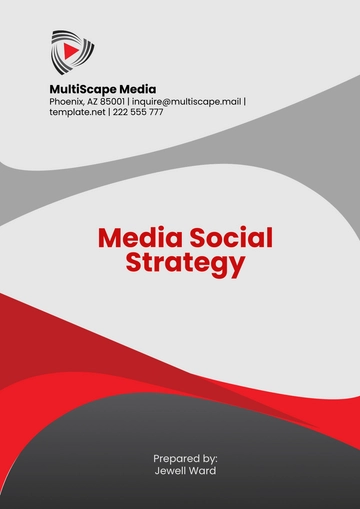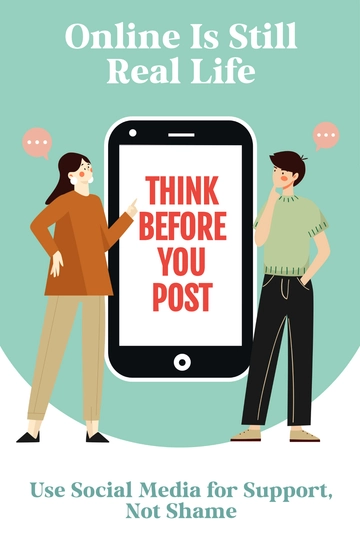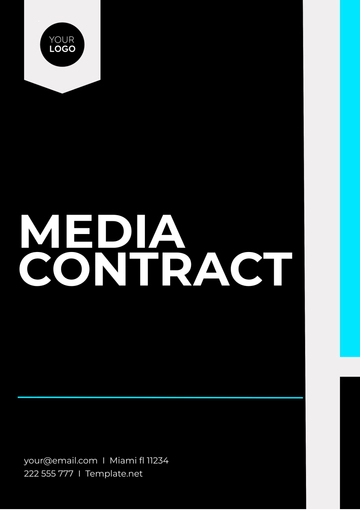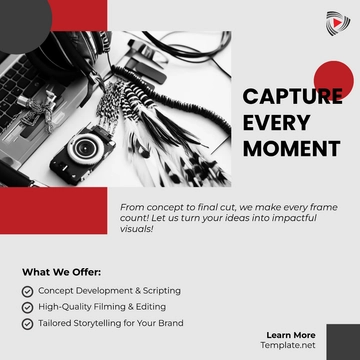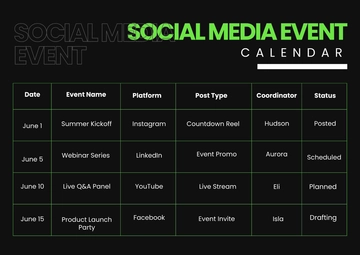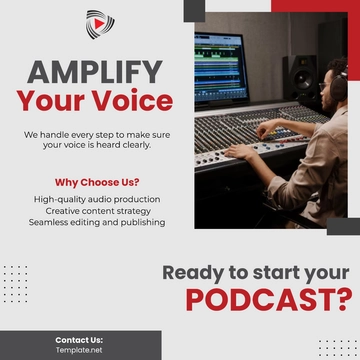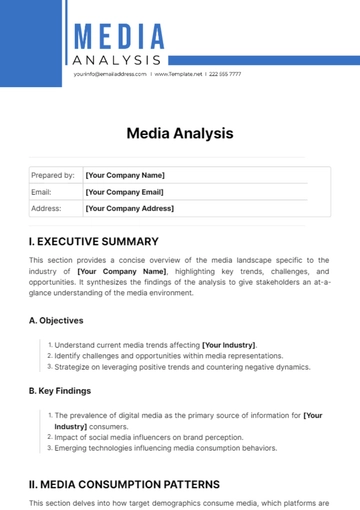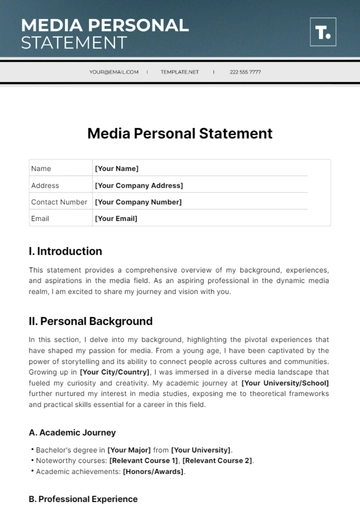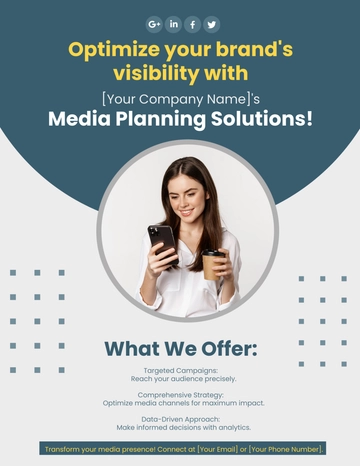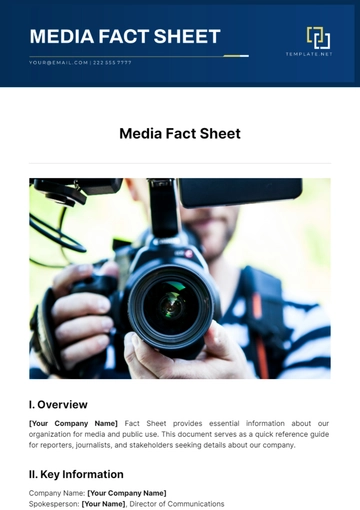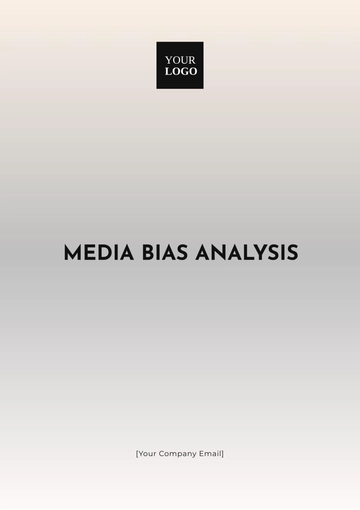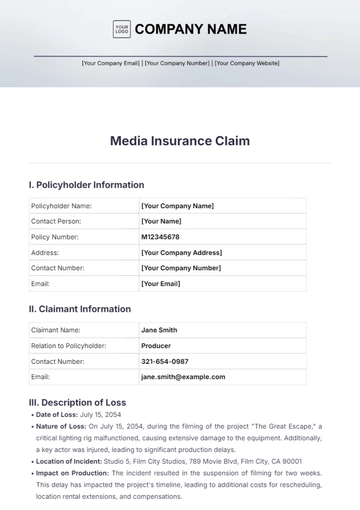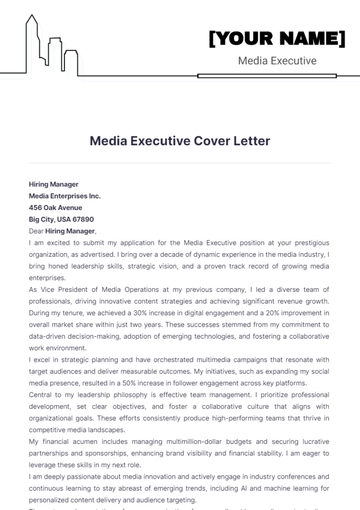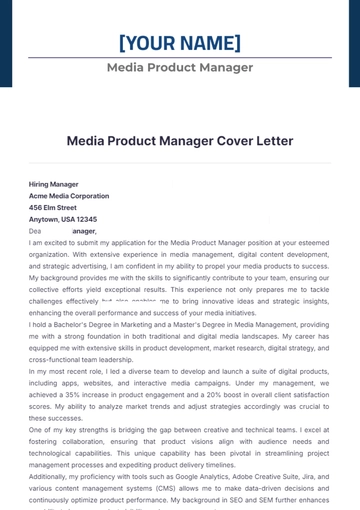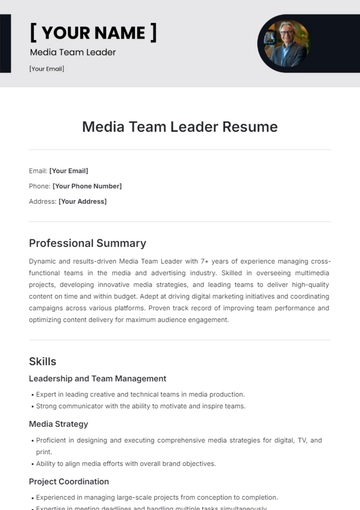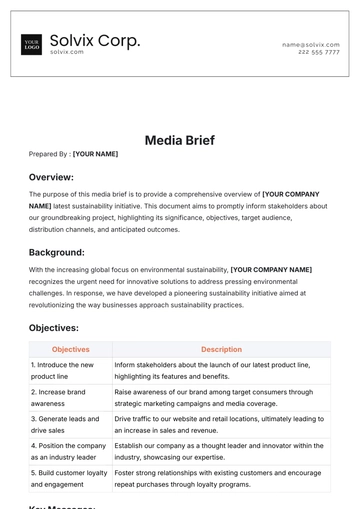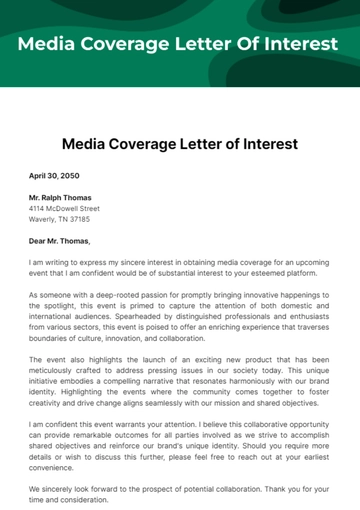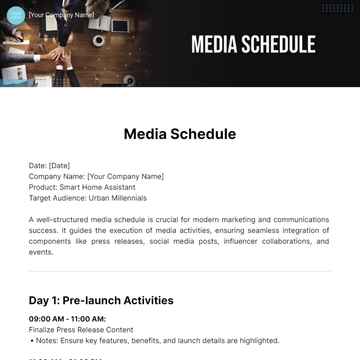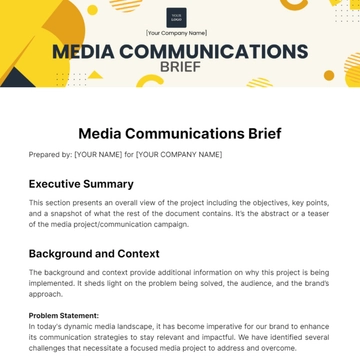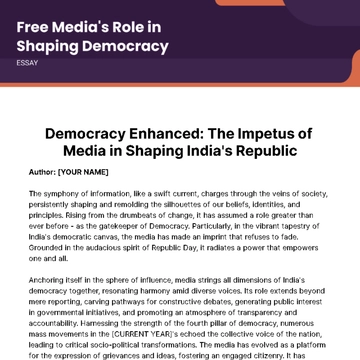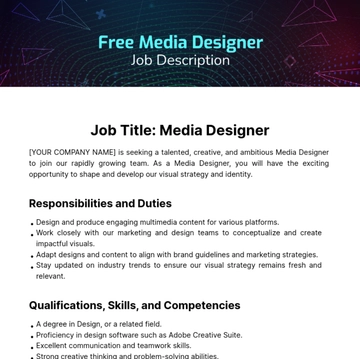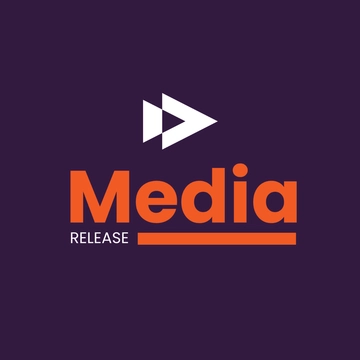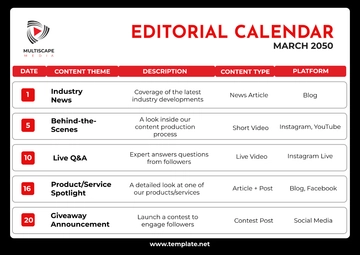Free Media Management
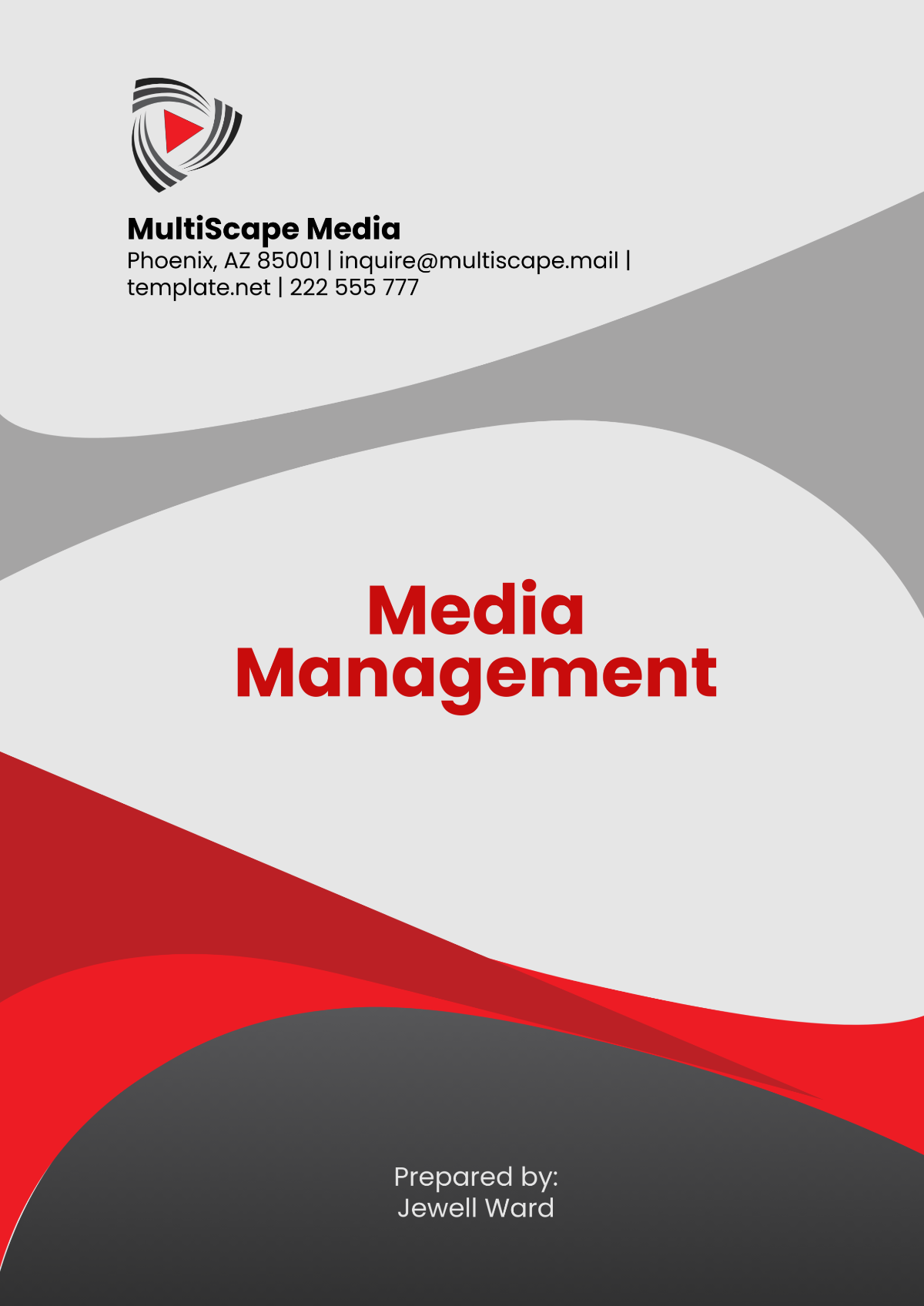
I. Introduction to Media Management
Media management is a pivotal part of modern business operations. It involves the strategic oversight and organization of media resources, content, platforms, and processes to ensure effective communication, branding, and audience engagement. In the context of the year 2050, the digital landscape has evolved significantly, making media management more complex and multifaceted. The explosion of new digital channels, the widespread use of artificial intelligence (AI) in content creation, and the increased reliance on data-driven decisions have redefined how companies manage their media assets.
For [Your Company Name], effective media management ensures that resources are allocated wisely, content is aligned with the company's goals, and the audience's experience is enhanced. As the media environment becomes more crowded and competitive, the need for a robust media management framework becomes even more critical. This document aims to provide a detailed overview of media management strategies, processes, and best practices that [Your Company Name] can implement to optimize its media operations and improve its bottom line.
II. Key Components of Media Management
A. Media Strategy
A well-defined media strategy is the foundation of successful media management. It involves setting clear objectives, identifying target audiences, selecting the right platforms, and aligning media activities with the overall goals of the business.
Goal Setting
Setting specific, measurable goals is the first step in building a successful media strategy. These goals could include increasing brand awareness, improving engagement rates, driving more website traffic, or generating leads.
For instance, [Your Company Name] might aim to increase its social media following by [20%] within the next year or improve engagement on its website by [15%] within the next six months. These clear, time-bound goals allow the team to focus on activities that will directly contribute to business growth.
Additionally, setting performance targets for media campaigns ensures that there is an ongoing measurement of success and areas for improvement.
Audience Analysis
Audience analysis is a critical step in ensuring that content is relevant and reaches the intended demographic. By understanding who the audience is, their behaviors, preferences, and pain points, [Your Company Name] can tailor its content and media channels to engage them effectively.
Tools like Google Analytics, Facebook Insights, and other social media analytics platforms can provide data on audience demographics, interests, and behaviors. This allows [Your Company Name] to create detailed audience personas that guide content creation and campaign targeting.
Regularly updating these personas ensures that the company can adapt to shifts in audience preferences over time. For example, if analytics show that a particular audience segment is increasingly using TikTok, the media strategy should incorporate more video content targeted at this demographic.
Platform Selection
In the digital age, there is no shortage of platforms available for media distribution. However, not all platforms will be suitable for every brand or campaign. Choosing the right platforms is crucial for maximizing the impact of media efforts.
For example, [Your Company Name] may find that platforms like LinkedIn, Twitter, and YouTube are the most effective channels for B2B communications, while Instagram and TikTok might be better suited for B2C marketing. The key is to assess where the target audience is most active and where the content will have the most significant impact.
Regularly reviewing platform performance and trends ensures that [Your Company Name] stays up to date with shifts in user behavior. Platforms like YouTube or TikTok, for instance, may see a surge in popularity, while older platforms like Facebook could become less relevant.
B. Media Content Development
The content is the heart of media management. It is what captures the audience's attention, communicates the brand's message, and drives engagement.
Content Types
To create a comprehensive media strategy, [Your Company Name] should diversify its content types. Different content formats engage audiences in various ways and should be tailored to each platform's best practices.
Textual Content: Blog posts, articles, press releases, and other written formats help establish thought leadership and position [Your Company Name] as an expert in its field. For instance, publishing informative articles about industry trends can attract organic traffic from search engines and encourage audience engagement.
Visual Content: Images, infographics, and videos play an essential role in capturing attention, especially on platforms like Instagram, YouTube, and TikTok. Visual content is more likely to be shared, leading to increased exposure and engagement.
Interactive Content: Quizzes, polls, and live-streaming events are examples of interactive content that actively involve the audience. Interactive content fosters deeper connections with the brand and encourages users to spend more time with the content.
Content Calendar
A content calendar is crucial for planning and scheduling content distribution effectively. It helps ensure that content is published consistently and aligns with marketing campaigns, product launches, or seasonal promotions.
The calendar should detail the type of content to be published, the platforms to use, and the best time to post based on audience activity. For instance, posting articles on the company blog every Tuesday, social media posts every Wednesday, and YouTube videos on Fridays can help maintain a steady flow of content.
Example:
Date
Content Type
Platform
Objective
2050-01-01
Blog Post
Website
Generate leads
2050-01-05
Video
YouTube
Increase brand awareness
Quality Control
Quality control in media content ensures that all outputs meet high standards and are aligned with [Your Company Name]'s branding guidelines.
To maintain consistency, the company should implement a review process where content is checked for errors in grammar, compliance with legal requirements, and alignment with the brand voice.
Automated tools can assist in identifying plagiarism, broken links, and other potential issues before content is published, ensuring the integrity of the content remains intact.
C. Media Resource Allocation
Efficient resource allocation ensures that [Your Company Name] uses its budget and workforce in the most effective way possible. This includes allocating funds for paid media, setting aside resources for content production, and ensuring teams have the necessary tools to succeed.
Budget Planning
Effective media management requires careful budgeting to ensure that funds are allocated to the right activities. Media budgets should account for paid advertising campaigns, content creation, influencer partnerships, and tools for analytics and scheduling.
In 2050, digital advertising costs continue to rise, making it essential for businesses to optimize their media spend. For instance, [Your Company Name] may allocate [50%] of its media budget to paid advertisements on platforms like Google and Facebook and another [30%] to content production.
Allocation for 2050:
Category
Budget ($)
Paid Advertising
50,000
Content Production
30,000
Software and Analytics
20,000
Human Resources
Media management requires a well-trained and dedicated team of professionals, including content creators, strategists, analysts, and community managers.
Investing in the professional development of these team members is crucial for maintaining a competitive edge. Regular training on new tools, trends, and strategies will help keep the team at the forefront of media management best practices.
Hiring specialists such as social media managers, video editors, and data analysts can further streamline media operations and ensure that each campaign runs smoothly and efficiently.
Technology Integration
Technology plays an essential role in modern media management. From social media management tools like Hootsuite and Buffer to advanced analytics platforms like Tableau, technology helps streamline operations and enhance decision-making.
Automation tools can be used for scheduling content, responding to customer inquiries, and even running A/B tests on ad campaigns. AI and machine learning are being leveraged to predict trends, personalize content, and improve campaign performance.
III. Processes in Media Management
A. Planning and Scheduling
Media Campaign Planning
Successful media management starts with effective planning. A well-thought-out campaign should have clearly defined goals, a strategic approach, and a timeline for execution.
The process should begin with setting Key Performance Indicators (KPIs) such as click-through rates (CTR), return on investment (ROI), or customer acquisition costs (CAC). These KPIs help [Your Company Name] assess whether the campaign meets its objectives and guides future decisions.
Additionally, campaigns should be broken down into phases: planning, creation, distribution, monitoring, and optimization.
Scheduling Tools
Tools like Hootsuite, Buffer, and Sprout Social help streamline scheduling by automating the posting of content at optimal times. These tools can schedule posts across multiple platforms and ensure consistent messaging.
By analyzing audience behavior, these tools can determine the best time to post, increasing the chances of higher engagement rates.
Using these tools also helps [Your Company Name] maintain a consistent presence on various platforms, even during times when teams may not be available to post manually.
B. Content Distribution
Cross-Platform Posting
Effective content distribution requires tailoring content to suit the platform it will appear on. For example, Instagram is visual, so posts should focus on striking images and short videos. Twitter requires concise, witty text, while LinkedIn calls for more formal, in-depth content.
Distributing content across multiple platforms maximizes reach and ensures that [Your Company Name] connects with different audience segments. However, it's important to monitor the performance on each platform and adjust the strategy accordingly.
Third-Party Collaborations
Collaborating with influencers and other brands can extend [Your Company Name]'s reach and credibility. Influencers with a substantial following can create content that highlights the brand and its offerings.
It’s essential to track ROI from these collaborations by using unique tracking links or affiliate codes to monitor conversions.
C. Media Monitoring
Performance Metrics
Media monitoring tools like Google Analytics, SEMrush, and social listening tools provide real-time data on the performance of media campaigns. These insights are crucial for evaluating the effectiveness of the strategy and making adjustments.
Key metrics to track include engagement rates, conversion rates, reach, and cost-per-click (CPC). Regular monitoring ensures that campaigns remain on track and adjustments can be made if the results aren’t meeting expectations.
Sentiment Analysis
Sentiment analysis tools powered by AI allow [Your Company Name] to gauge public perception of the brand in real time. By analyzing social media mentions and online reviews, the company can measure how its audience feels about the brand.
Proactively responding to both positive and negative feedback helps maintain a positive relationship with the audience and strengthens brand loyalty.
IV. Advanced Media Management Practices
A. Data-Driven Decision-Making
Analytics Tools
In today’s data-driven world, analytics is a cornerstone of media management. [Your Company Name] can leverage advanced analytics tools such as Tableau, Power BI, or custom dashboards to monitor performance metrics and uncover insights.
By using predictive analytics, the company can anticipate trends, identify potential challenges, and make data-backed decisions that drive media success.
Key Metrics to Monitor
The performance of campaigns can be evaluated by tracking metrics such as Cost Per Click (CPC), Customer Acquisition Cost (CAC), Conversion Rates, and Return on Investment (ROI).
For instance, [Your Company Name] may set a goal to keep CPC below $[1.50] and to achieve a conversion rate of [5%] or higher. By monitoring these metrics, the company can adjust strategies to optimize performance.
V. Leveraging Emerging Technologies in Media Management
A. Artificial Intelligence (AI) and Automation
AI-Powered Content Creation
As the use of AI continues to grow in 2050, companies like [Your Company Name] can significantly enhance their media management by adopting AI tools for content creation. AI-powered platforms can generate text-based content, design visuals, and even produce basic videos based on specific guidelines. This reduces the time required for content production and ensures consistent quality across multiple formats.
AI tools, such as OpenAI’s GPT models, can help generate blog posts, social media captions, or product descriptions. For instance, [Your Company Name] might use an AI tool to quickly draft articles about industry trends or create product descriptions for new launches, allowing the content team to focus on refining and adding a personalized touch.
Additionally, AI can tailor content recommendations based on individual user preferences, improving engagement rates and customer satisfaction.
Automation in Media Scheduling and Posting
With the help of automation tools, [Your Company Name] can schedule posts in advance, ensuring that content is consistently published at peak engagement times. These tools can automatically adjust to time zones, ensuring that content is posted when the target audience is most likely to interact.
Automating social media posting through platforms like Hootsuite, Sprout Social, or Buffer can save time and ensure that campaigns run smoothly, even when team members are not actively managing them. Moreover, automated responses, such as chatbot interactions or email marketing follow-ups, can help provide immediate engagement with users, enhancing their experience with the brand.
Automation helps reduce the administrative burden on the team, allowing more focus on strategic initiatives such as campaign optimization and content innovation.
Predictive Analytics for Campaign Optimization
Predictive analytics, powered by AI and machine learning, can help [Your Company Name] anticipate future trends based on historical data. This type of analysis can predict customer behavior, campaign success, and even changes in market conditions.
By leveraging AI-driven predictive analytics, [Your Company Name] can adjust its media strategy proactively. For example, AI could predict that a particular campaign will experience a drop in engagement due to seasonal trends or competitor activity, allowing the company to pivot and optimize its efforts before problems arise.
Predictive analytics can also enhance personalization by suggesting the most relevant content to individual users based on past interactions, which increases the likelihood of converting them into customers.
B. Blockchain Technology for Media Transparency
Ensuring Transparency in Media Buying
With the rise of blockchain technology, media buying in 2050 is becoming more transparent, secure, and efficient. Blockchain allows for the creation of smart contracts and the tracking of media transactions in real time, which provides both advertisers and publishers with an immutable record of all exchanges.
For [Your Company Name], adopting blockchain technology in media buying ensures that every dollar spent on advertising is accounted for. Smart contracts can automatically verify and execute advertising agreements, reducing the need for intermediaries and ensuring that the media budget is allocated efficiently.
Blockchain can also help track ad fraud by verifying impressions, clicks, and other metrics, ensuring that [Your Company Name]'s paid media spend is used effectively and that fraudulent activities are minimized.
Content Ownership and Intellectual Property Protection
Blockchain also plays a role in protecting the intellectual property rights of content creators. By leveraging decentralized networks, [Your Company Name] can secure the ownership of digital media assets, ensuring that the company’s content is not misused or plagiarized.
For example, a blockchain system could automatically record the creation of videos, blog posts, or other assets, making it easy for [Your Company Name] to prove ownership in case of disputes or theft. This increases trust with content creators and ensures that [Your Company Name]'s intellectual property is safeguarded.
VI. Advanced Media Metrics and KPIs
A. Performance Metrics for Media Campaigns
Engagement Rate
The engagement rate is one of the most essential metrics to measure the success of any media campaign. It reflects how well the audience interacts with the content. Metrics like likes, shares, comments, and video views fall under this category. For social media campaigns, the engagement rate is often calculated by dividing the total number of engagements by the total number of followers or impressions.
For [Your Company Name], an engagement rate of [5%] or higher would be considered strong, although this varies by platform and industry. High engagement rates typically signify that the content resonates with the target audience, leading to more significant brand recall and potential conversions.
Return on Investment (ROI)
ROI is another key metric for evaluating the success of a media campaign. It measures the return from media spend relative to the cost of the campaign. For paid media campaigns, the ROI can be calculated by dividing the revenue generated by the campaign by the total spend.
For instance, if [Your Company Name] spent $[50,000] on a campaign and generated $[200,000] in revenue, the ROI would be [4:1], meaning that for every dollar spent, [$4] were returned in revenue. Tracking ROI ensures that media resources are being allocated to campaigns that provide the best value for money.
Customer Acquisition Cost (CAC)
Customer Acquisition Cost (CAC) is a crucial metric that tracks how much it costs to acquire a new customer through a particular media campaign. This includes all the costs related to the campaign, such as ad spend, content creation, and any third-party fees, divided by the total number of customers acquired.
For example, if [Your Company Name] spent $[100,000] on a campaign and acquired [500] new customers, the CAC would be $[200]. A lower CAC indicates that the company is efficiently acquiring customers at a sustainable cost, contributing to overall profitability.
Click-Through Rate (CTR)
The Click-Through Rate (CTR) is a metric used to evaluate the effectiveness of digital ads. It measures how often people click on an ad after seeing it. A higher CTR typically indicates that the ad is compelling and relevant to the audience.
For digital campaigns, [Your Company Name] should aim for a CTR of at least [2%], though this can vary depending on the platform and industry. By improving CTR, [Your Company Name] can lower CPC and increase conversion rates, improving overall campaign efficiency.
B. Advanced Data Analytics and Insights
Audience Segmentation
Audience segmentation is an essential practice for tailoring content to different groups within a target market. By segmenting audiences based on demographics, interests, behaviors, and previous interactions, [Your Company Name] can deliver personalized content that resonates more effectively.
Data analytics platforms such as Google Analytics, HubSpot, or advanced CRM systems can provide granular insights into audience behavior. For example, segments could include age, location, purchasing behavior, and engagement history. This segmentation enables [Your Company Name] to craft targeted campaigns that appeal to specific customer needs and preferences.
A/B Testing
A/B testing is a method of comparing two versions of a piece of content or an ad to see which performs better. For example, [Your Company Name] could run two different versions of a landing page or social media ad with slight variations (such as different headlines or images) to determine which version yields higher conversion rates.
A/B testing is crucial for optimizing media campaigns, as it allows [Your Company Name] to test hypotheses and refine content based on real-time performance data. This iterative approach ensures that the most effective media assets are used in campaigns moving forward.
Heatmaps and User Journey Mapping
Tools like heatmaps and user journey mapping provide visual insights into how users interact with digital content. Heatmaps track where users click, scroll, and engage on a website or page, allowing [Your Company Name] to optimize layout and design for better user experience.
User journey mapping helps visualize the steps customers take from initial awareness to final conversion. By understanding how users navigate through the website or media touchpoints, [Your Company Name] can identify barriers and optimize the flow to enhance conversion rates.
VII. Conclusion and Future Directions
Effective media management is more than just a strategic necessity—it is a key driver of [Your Company Name]'s ability to connect with its audience, strengthen its brand, and drive business growth in the digital age. As the media landscape continues to evolve, adopting innovative technologies such as AI, blockchain, and predictive analytics will be essential in staying competitive.
By implementing robust media strategies, utilizing advanced analytics, and continuously optimizing media campaigns, [Your Company Name] can ensure that its media resources are used effectively and efficiently. As trends shift and new platforms emerge, [Your Company Name] will be poised to leverage new opportunities and deliver content that resonates with its audience, drives engagement, and achieves measurable results.
In conclusion, media management is a dynamic and ongoing process that requires adaptability, creativity, and an analytical mindset. For [Your Company Name] to thrive in the year 2050 and beyond, it must embrace the full spectrum of media management tools and strategies, ensuring that every piece of content, every campaign, and every interaction delivers value to its audience and helps achieve the company’s long-term goals.
- 100% Customizable, free editor
- Access 1 Million+ Templates, photo’s & graphics
- Download or share as a template
- Click and replace photos, graphics, text, backgrounds
- Resize, crop, AI write & more
- Access advanced editor
Enhance your media operations with the Media Management Template from Template.net. Editable and customizable, this template helps organize and track campaigns effectively. Adjust it using the AI Editor Tool to align with your media goals.
